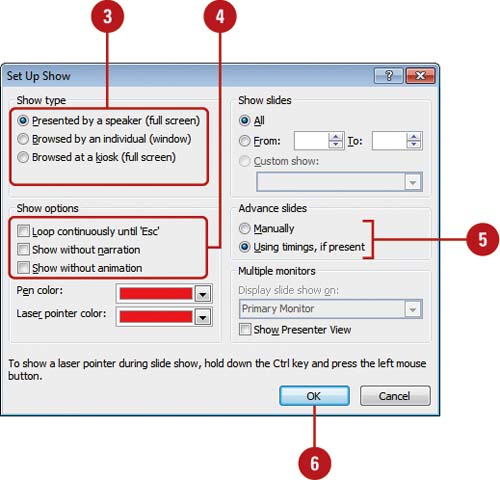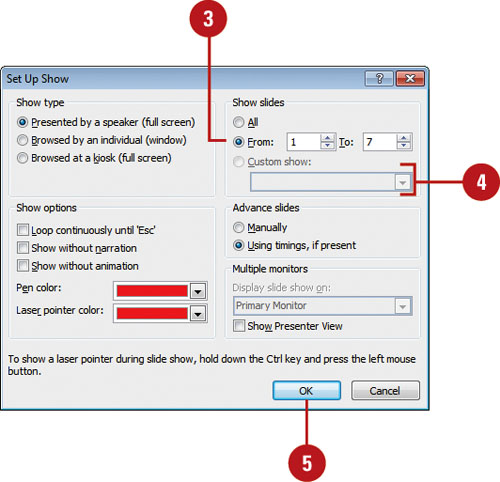PowerPoint offers several types of slide
shows appropriate for a variety of presentation situations, from a
traditional big-screen slide show to a show that runs automatically on
a computer screen at a conference kiosk. When you don’t want to show
all of the slides in a PowerPoint presentation to a particular
audience, you can specify a custom show or only a range of slides to
show. You can also set show options to run continuously or without
narration or animation, and change the pen or laser pointer (New!) color.
Set Up a Show
- 1. Click the Slide Show tab.
- 2. Click the Set Up Slide Show button.
- 3. Choose the show type you want.
- Click the Presented by a speaker option to run a full screen slide show.
- Click the Browsed by an individual option to run a slide show in a window and allow access to some commands.
- Click the Browsed at a kiosk option to create a self-running, unattended slide show.
- 4. Select or clear the following show options check boxes:
- Loop continuously until ‘Esc’. Select to replay the slide show again until you stop it.
- Show without narration. Select to not play narration.
- Show without animation. Select to not play animation.
- 5. Select the Manually or Using timings, if present option.
- 6. Click OK.
 - 7. Click the Resolution list arrow, and then click Use Current Resolution, or select a resolution.
- 8. If you have multiple monitors, click the Show Presentation On list arrow, and then select a monitor.
|
The quality of a display system depends on its
screen resolution, how many pixels it can display, and how many bits
are used to represent each pixel. The screen resolution signifies the
number of dots (pixels) on the entire screen. A higher screen
resolution, such as 1024 by 768, makes items appear smaller, while a
lower screen resolution, such as 640 by 480, makes items appear larger,
which can help make a slide show easier to view.
|
Show a Custom Show or Range of Slides
- 1. Click the Slide Show tab.
- 2. Click the Set Up Show button.
- 3. To show a range of slides, click the From option, and then enter the first and last slide numbers of the range you want to show.
- 4. To show a custom show, click the Custom Show option, and then select a custom show.
- 5. Click OK.

Set Pen and Laser Pointer Color
- 1. Click the Slide Show tab.
2. Click the Set Up Show button.
- 3. Click the Pen or Laster pointer color list arrow, and then select a color.
- 4. Click OK.

Did You Know?
You can turn your mouse into a laser pointer. In Slide Show view, hold down Ctrl, click the left mouse button, and then begin pointing ( New!).
|